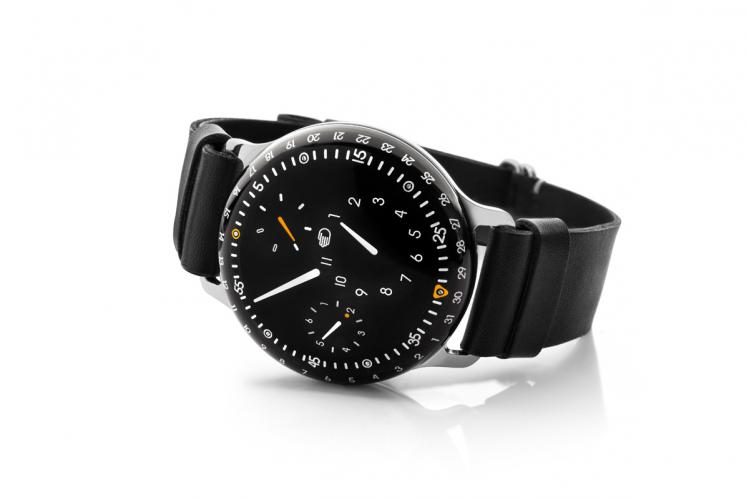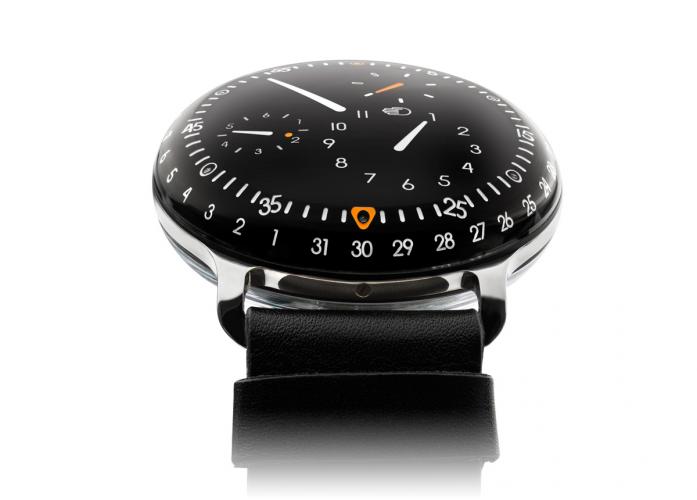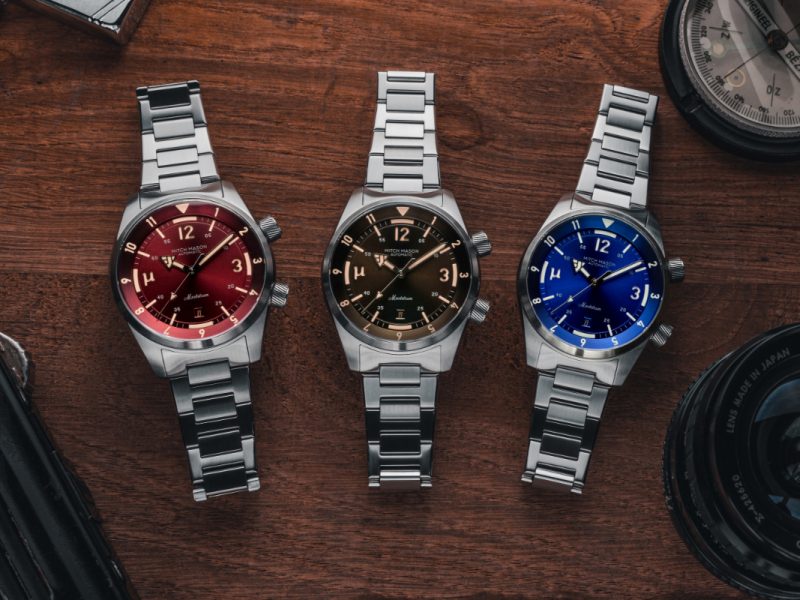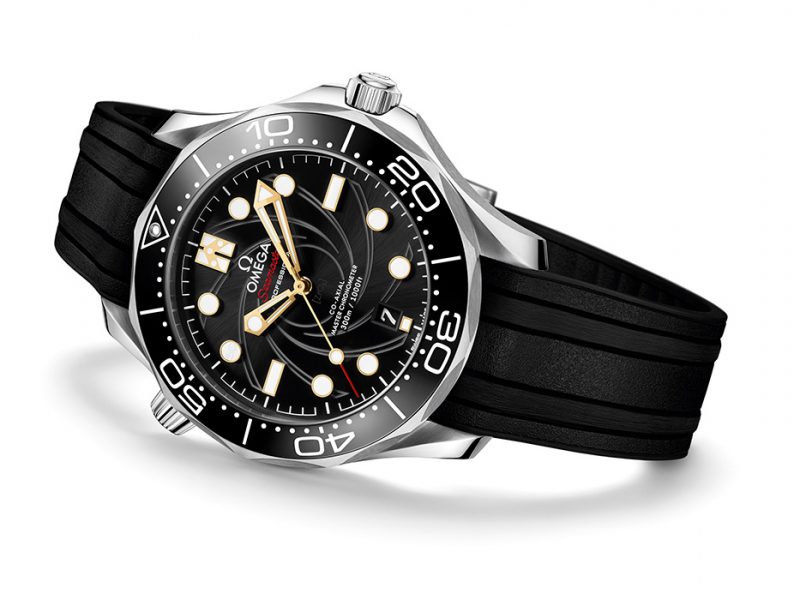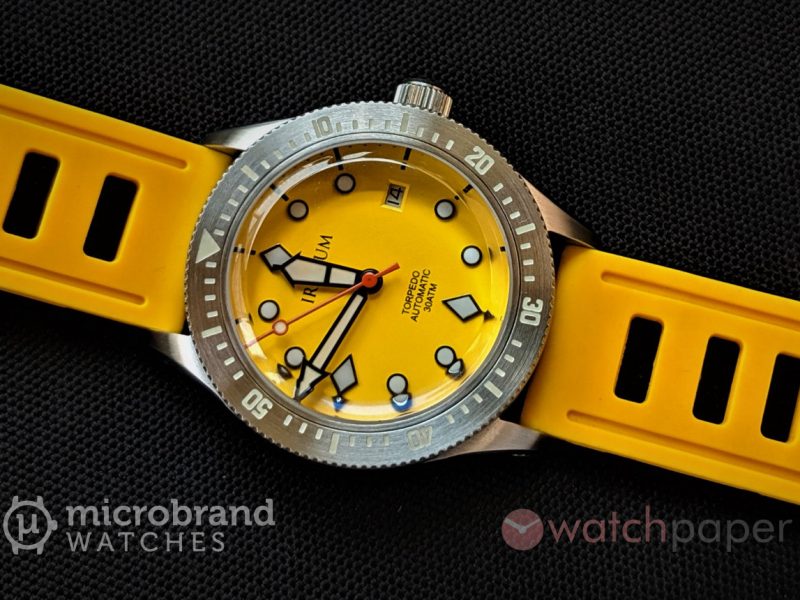A Convex Look at Time with Ressence Type 3
The ultramodern look of the sleek Ressence Type 3 is incomparable. The black and white face is simple yet sleek and there is no denying that the convex curve of the glass and the liquid filled dial, gives this watch an appearance like no other.
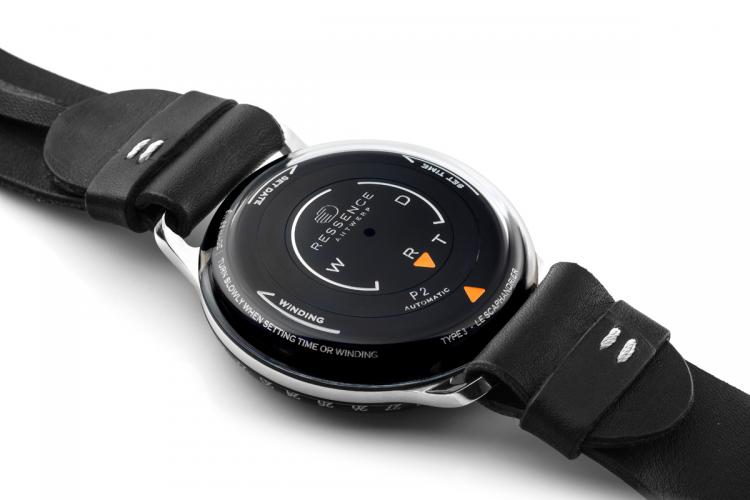
Don’t look for the crown on the Ressence Type 3, you’ll have to wound it up by turning the case back.
The Ressence Type 3 brings time to the surface
The Ressence Type 3 transports time from the dial to the crystal. The orbiting indications are bathed in a fluid that refracts light like air does, so the indications appear to be displayed directly onto the sapphire – closer to the eye of the beholder. The high-contrast white indicators against the black dial appear to be projected onto the top crystal as if onto a screen. Type 3 offers a tangible feeling of being able to touch time itself.
Discs displaying hours, minutes, seconds and days revolve under the domed sapphire crystal, while the date is read from the perimeter of the dial at 6 o’clock. The indications discs continually revolve, as does the whole dial itself. The face of the watch is constantly changing in the same way that a human face is transformed by each passing emotion.
With the Type 3, Benoît Mintiens, the founder of Ressence, concentrates on the user experience rather than on creating a showcase for the workings of a watch. Traditional hands are replaced by convex discs set in a convex dial, providing an abstract representation of pared-down and poetic time. Lines painted on the hours, minutes and seconds discs indicate the time just like traditional hands, but unlike traditional hands, they do not overlap so less space is required between the dial and the crystal.
The Type 3 is a mechanical watch; however the illusion of seeing indications appear on the sapphire crystal as if they were on a computer screen is reinforced by the pronounced curve of the glass and a “water drop” effect that accentuates the black/white contrast of the dial.
The Type 3 provides proof of Leonardo Da Vinci’s adage that “simplicity is the ultimate sophistication”, because in order to take this new step forward, Benoît Mintiens had to develop some very original technical solutions.
The indications and their mechanisms are mounted inside a bubble crafted from extremely tough, anti-reflective sapphire crystal. The complication and indications follow the shape of the crystal. The mechanism (28 gears, 57 jewels) is enclosed in an upper compartment filled with a naphtha-type liquid that has a more similar index of refraction to the sapphire crystal than air does. Refraction bends light when it passes from one material to another, e.g. air-to-glass or glass-to-air. With the fluid-filled dial indications, refraction is greatly minimised, which tricks the brain into eliminating the impression of depth. A thermal valve automatically adjusts for any expansion or contraction of the fluid.
An unbroken hermetic titanium membrane between the upper section housing the complication module and indications and the movement prevents any physical connection, so the information is transmitted magnetically. The automatic winding movement is protected by a Faraday cage to minimise the effects of magnetic fields on timing.
The name Ressence is a portmanteau assimilating the words renaissance and essence, and stands for the rebirth of what is essential to a watch, to displaying time. Ressence’s quest for “the essential”, which began with the replacement of traditional hands by flat discs, has taken another step forward in the Type 3 with the absence of a crown as well. The complete sapphire case back rotates and takes the role of the crown. A gravitational gearing system allows the indications to be adjusted separately: with the dials facing up, it is possible to change the time and date; with the back up, the watch can be wound.
Like the dial side, the back is curved convexly so that its centre touches the wrist between the bones, ensuring that the Type 3 is a very comfortable watch to wear.
The Type 3 in detail
One of the most striking features of the Type 3 is its surface time display that, while not using traditional hands, uses the concept of hands to display the time. The Type 3 displays time as if it were projected onto a screen. Unlike watches with hands, where several layers of information are superimposed, the Ressence display system projects the information onto the outside of the sapphire crystal, eliminating the last perceptible barrier between the dial and the eye – the refraction of the glass. The brain uses reflection and refraction to understand shape and depth. Filling the display with fluid removes the visual reference points that the brain uses to perceive the shape. The effect is amplified by the play of shadows on the spherical dial: It has to be touched to be believed.
The ergonomics of displaying time
This unique concept of a projected display would be impossible with traditional overlapping hands. However, the indications are still read in the same way as traditional hands, because we have learnt to tell the time using hands and once the skill has been mastered, the eye no longer reads the hour but interprets the angle between the two hands.
The TYPE 3 uses the whole surface of the crystal to display the indications so they can be read from very shallow angles – submerging the display module in liquid increases the contrast between the white indicator ‘hands’ and the black dial. The black DLC becomes even darker in fluid, appearing to absorb light. The high contrast of the white indications against the jet-black dial deconstructs time and pares it back to its essence.
Setting the time without a crown
Ressence design is characterised by purity and minimalism. This quest for pared-down design includes the process of deconstructing the timepiece; a process illustrated by the elimination of traditional hands and by the invisible fluid technology used to project the indications. And by removing the crown, the TYPE 3 opens up a whole new chapter in this quest for simplicity. The sapphire case back fulfils the functions of the crown with quadrants on the case back replacing different crown positions. The Type 3 is wound up by turning the case back. To change the date, it is simply necessary to make a longer rotation through 200° in order to arrive at the date quadrant. The hour is set by starting from the neutral position and turning in the direction indicated. A gravitational gearing system allows time setting to be disconnected by simply inverting the watch.
Architecture and system
The TYPE 3 consists of three basic elements: a central section is made from a 2mm titanium plate that integrates the lugs for the bracelet; an upper liquid-filled capsule with the complication and indications submerged in naphtha; and a lower section housing the movement (inside a Faraday cage) and winding/time-setting functions. The upper display module is completely sealed and physically separate from the movement. The indications are transmitted from the movement to the upper display via micro-magnetic fields.
Time display module
The dial and indications are curved (radius 125mm) and treated with DLC (diamond-like carbon). All the components are titanium with the exception of the gears. The indications, engraved in the discs are filled with Super-LumiNova (white, grey and orange). The display system has been invented developed and patented by Ressence and comprises 28 gears and 57 jewels (out of 82 jewels in total), three offset bi-axial satellites and an exterior date ring. The upper module also includes a gimbal, a shock absorption system and is totally filled with fluid. A thermostatic valve system allows for any expansion or contraction of the liquid due to the ambient temperature. By virtue of the convex curve of the dial, the angle of the satellite indications is approximately 3° for the hours and 4.75° for the seconds.
Type 3 Technical Specifications
The Ressence Type 3 is a limited edition of 50 pieces
FUNCTIONS:
Date, Days, Hours, Minutes, Seconds ( 360’’ )
ARCHITECTURE:
Sandwich construction with titanium membrane between movement and fluid-filled indication module.
SYSTEM:
Information transmitted from movement to indications by micro-magnetic fields .
CASE:
Sapphire crystal and grade 5 titanium
DIMENSIONS:
44mm x 15mm
CRYSTALS:
Domed sapphire crystals top and bottom with anti-reflective coating on both sides
INDICATIONS:
Convex dial and indications (radius: 125mm) in grade 5 titanium with black DLC.
Indications engraved and filled with white, grey and orange Super-LumiNova, glowing green and orange in the dark.
MODULE:
Patented system invented and developed by Ressence.
Independent module comprising 28 gears and 57 jewels
Grade 5 titanium plate integrating three eccentric biaxial satellites inclined at 3° and 4,75° with a date ring around the circumference.
Shock absorber system including gimbal system.
The module and indications are completely immersed in fluid.
A thermal valve compensates for expansion/contraction of the fluid
MOVEMENT:
Automatic winding movement based on calibre 2824-2
120 components, 25 jewels
Power reserve 36 hours,
Balance frequency 28.800 A/h
Visible ring-shape winding rotor
COMPONANTS:
Total: 407 components, module alone: 287 components.
WEIGHT:
175 grams
Ressence Timeline
2010: Ressence exhibits at Basel with prototype of the SeriesOne
2011: ZeroSeriesOne launched. This was a pre-production series of 50 pieces (30 in aluminium, 20 in titanium).
2012: SeriesOne launched bearing the ‘Swiss Made’ label.
2013: Launch of Type 3 at Baselworld 2013.
Benoît Mintiens, Ressence founder
Born in Belgium, Benoît Mintiens initially planned to be a naval engineer, but then decided on a career as an industrial designer. He graduated in Industrial Design in Antwerp in 1998 and took up the position of Senior Consultant at Antwerp design firm Enthoven & Associates. While he was working at there, he also gained his MBA at Vlerick Business School in 2003.
Benoît Mintiens had always been attracted to the idea of creating a new kind of watch. Around 2004, a friend presented him with an opportunity to do just that when he asked him to create an original design for a men’s watch featuring as many diamonds as possible. Benoît chose to use diamonds for their functional attributes and in particular their refractive qualities. But while he was working on a prototype, another brand launched a model based on a similar idea to his own, and Benoît’s design was put on hold. His appetite for watch design had been whetted and in 2007 Benoît finished designing his first watch, the SeriesOne which included Ressence’s now iconic rotating flat discs, which replaced traditional hands. In 2009 Benoît founded Ressence and launched the brand at Baselworld the same year. In January 2011, the SeriesOne watch was awarded second prize in the Super Watch Awards organised by the Geneva Time Exhibition, with it gaining a special mention from the jury.


